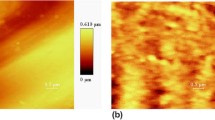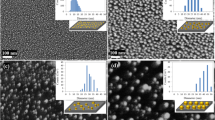Abstract
The well-aligned carbon nanotubes (CNTs) arrays with opened ends were prepared in ordered pores of anodic aluminum oxide (AAO) template by the chemical vapor deposition (CVD) method. After then, silicon nanowires (SiNWs) were deposited in the hollow cavities of CNTs. By using this method, CNTs/SiNWs core-sheath composite structure arrays were synthesized successfully. Growing structures and physical properties of the CNTs/SiNWs composite structure arrays were analyzed and researched by the scanning electron microscopy (SEM), transmission electron microscopy (TEM) and X-ray diffraction spectrum (XRD), respectively. The field emission (FE) behavior of the CNTs/SiNWs composite structure arrays was studied based on Fowler-Nordheim tunneling mechanism and current-voltage (I-V) curve. And the photoluminescence (PL) was also characterized. Significantly, the CNTs/SiNWs core-sheath composite structure nanowire fabricated by AAO template method is characteristic of a metal/semiconductor (M/S) behavior and can be utilized to synthesize nanoscale PN junction or Schottky diode device. This process also could be useful for the fabrication of SiNWs and other nanoscale core-sheath composite structure nanowires with chemically inert interfaces for nanoscale electronic and device applications where surface oxidation is undesirable. The diameters and lengths of nanoscale composite structure arrays can be dominated easily, and the experimental result shows that the curling and twisting structures are fewer than those prepared by other synthesized methods.
Similar content being viewed by others
References
Wang, N., Tang, Y. H., Zhang, Y. F. et al., Nucleation and growth of Si nanowires from silicon oxide, Phys. Rev., B, 1998, 58: 16024–16026.
Yan, H. F., Xing, Y. J., Hang, Q. L. et al., Growth of amorphous silicon nanowires via a solid-liquid-solid mechanism, Chem. Phys. Lett., 2000, 323: 224–228.
Zhou, G. W., Zhang, Z., Yu, D. P., Growth morphology and micro-structural aspects of Si nanowires synthesized by laser ablation, J. Crystal. Growth., 1999, 197: 129–135.
Liu, J. L., Shi, Y., Wang, F. et al., Fabrication of silicon quantum wires by anisotropic wet chemical etching and thermal-oxidation, J. Vac. Sci. Technol., B, 1995, 13: 2137–2142.
Leobandung, E., Guo, L., Wang, Y. et al., Single hole quantum-dot transistors in silicon, Appl. Phys. Lett., 1995, 67(16): 2338–2342.
Wang, N., Zhang, Y F., Tang, Y H. et al., SiO2-enhanced synthesis of Si nanowires by laser ablation, Appl. Phys. Lett., 1998,73:3902–3905.
Morales, A. M., Lieber, C. M., A laser ablation method for the synthesis of crystalline semiconductor nanowires, Science, 1998, 278:208–213.
Zhou, X. T., Zhang, R. Q., Peng, H. Y. et al., Highly efficient and stable photoluminescence from silicon nanowires coated with SiC, Chem. Phys. Lett., 2000, 332: 215–218.
Zhang, Y F., Tang, Y. H., Zhang, Y. et al., Deposition of carbon nanotubes on Si nanowires by chemical vapor deposition, Chem. Phys. Lett., 2000, 330: 48–52.
Wu, Y. Y., Yang, P. D., Germanium/carbon core-sheath nanostructures, Appl. Phys. Lett., 2000, 77(1): 43–45.
Hu, J. T., Min, O., Yang, P. D. et al., Controlled growth and electrical properties of heterojunctions of carbon nanotubes and silicon nanowires, Nature, 1999, 399(6): 48–51.
Jessensky, O., Muller, F., Goseld, U. et al., Self-organized formation of hexagonal pore arrays in anodic alumina, Appl. Phys. Lett., 1998, 72(10): 1173–1181.
Pan, Z. W., Xie, S. S., Chang, B. H. et al., Direct growth of aligned open carbon nanotubes by chemical vapor deposition, Chem. Phys. Lett., 1999, 299: 97–100.
Pan, S. L., Zhang, H. L., Li, H. H. et al., Gold nanowires prepared by template synthesis methods, Chemical Journal of Chinese Universities (in Chinese), 1999, 20(10): 1622–1624.
Wang, C. W., Li, M. K., Li, H. L., Well-aligned carbon nanotube array membrane synthesized in porous alumina template by chemical vapor deposition, Chinese Science Bulletin, 2000, 45(15): 1373–1376.
Furneaux, R. C., Rigby, W. R., Davidson, A. P., The formation of controlled- porosity membranes from anodically oxidized aluminium, Nature, 1989, 337(12): 147–149.
Tang, Y. H., Zhang, Y. F., Lee, S. T. et al., Morphology of Si nanowires synthesized by high-temperature, J. Appl. Phys., 1999, 85(11): 7981–7983.
Li, M. K., Wang, C. W., Li, H. L., Synthesis of ordered Si nanowire arrays in porous anodic aluminum oxide templates, Chinese Science Bulletin, 2001, 46(21): 1793–1796.
Wang, C. W., Li, M. K., Li, H. L., Well-aligned carbon nanotube array membrane and its field emission properties, Science in China, Series A, 2001, 44(2): 234–240.
Frederick, C. K. Au., Wang, K. W., Tang, Y H. et al., Electron field emission from silicon nanowires, Appl. Phys. Lett., 1999, 75(12): 1700–1702.
Author information
Authors and Affiliations
Corresponding author
Rights and permissions
About this article
Cite this article
Li, M., Lu, M., Wang, C. et al. Preparation of well-aligned carbon nanotubes/silicon nanowires core-sheath composite structure arrays in porous anodic aluminum oxide templates. Sc. China Ser. B-Chem. 45, 435–444 (2002). https://doi.org/10.1360/02yb9056
Received:
Issue Date:
DOI: https://doi.org/10.1360/02yb9056




